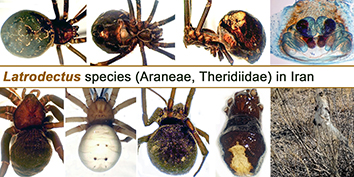Volume 10, Issue 1 (2024)
J. Insect Biodivers. Syst 2024, 10(1): 99-109 |
Back to browse issues page
Download citation:
BibTeX | RIS | EndNote | Medlars | ProCite | Reference Manager | RefWorks
Send citation to:



BibTeX | RIS | EndNote | Medlars | ProCite | Reference Manager | RefWorks
Send citation to:
Souri A M, Shafaie S, Moradmand M, Mirshamsi O. The spider genus Latrodectus Walckenaer, 1805 (Araneae, Theridiidae) in Iran with the first record of Latrodectus revivensis Shulov, 1948. J. Insect Biodivers. Syst 2024; 10 (1) :99-109
URL: http://jibs.modares.ac.ir/article-36-71998-en.html
URL: http://jibs.modares.ac.ir/article-36-71998-en.html
1- Department of Biology, Faculty of Science, Ferdowsi University of Mashhad, Iran
2- Department of Botany and Zoology, Faculty of Science, Masaryk University, Brno, Czech Republic
3- Department of Plant and Animal Biology, Faculty of Biological Science and Technology, University of Isfahan, Isfahan, Iran [1]; Department of Biogeography, Trier University, Trier, Germany [2].
4- Department of Biology, Faculty of Science, Ferdowsi University of Mashhad, Mashhad, Iran [1]; Research Department of Zoological Innovations (RDZI), Institute of Applied Zoology, Faculty of Science, Ferdowsi University of Mashhad, Mashhad, Iran [2]. , omid.mirshamsi@gmail.com
2- Department of Botany and Zoology, Faculty of Science, Masaryk University, Brno, Czech Republic
3- Department of Plant and Animal Biology, Faculty of Biological Science and Technology, University of Isfahan, Isfahan, Iran [1]; Department of Biogeography, Trier University, Trier, Germany [2].
4- Department of Biology, Faculty of Science, Ferdowsi University of Mashhad, Mashhad, Iran [1]; Research Department of Zoological Innovations (RDZI), Institute of Applied Zoology, Faculty of Science, Ferdowsi University of Mashhad, Mashhad, Iran [2]. , omid.mirshamsi@gmail.com
Abstract: (343 Views)
In this study, Latrodectus revivensis Shulov, 1948 is recorded for the first time from Iran based on female specimens. This species was previously recorded from the eastern Mediterranean region. As a result, the number of Latrodectus species recorded from Iran is raised to six. A comparative diagnosis is provided for this species and other widow spiders previously recorded from the country. Latrodectus revivensis can be easily distinguished from its congeners by colouration, genitalic characters and the shape of the nest. This record represents the easternmost distribution limit of L. revivensis. An updated distribution map of Latrodectus species is also provided.
Article Type: Research Article |
Subject:
Systematics/Other taxa
Received: 2023/10/15 | Accepted: 2023/12/16 | Published: 2024/01/1
Received: 2023/10/15 | Accepted: 2023/12/16 | Published: 2024/01/1
References
1. Agnarsson, I. (2004) Morphological phylogeny of cobweb spiders and their relatives (Araneae, Araneoidea, Theridiidae). Zoological Journal of The Linnean Society, 141, 447-626. [DOI:10.1111/j.1096-3642.2004.00120.x]
2. Andrade, M.C. & Banta, E.M. (2001) Female preference for prolonged courtship in redback spiders. Advances in Ethology, 36, 115.
3. Andrade, M.C. & Banta, E.M. (2002) Value of male remating and functional sterility in redback spiders. Animal Behaviour, 63 (5), 857-870. [DOI:10.1006/anbe.2002.2003]
4. Buzatto, B.A., Haeusler, L. & Tamang, N. (2021) Trapped indoors? Long-distance dispersal in mygalomorph spiders and its effect on species ranges. Journal of Comparative Physiology A, 207 (2), 279-292. [DOI:10.1007/s00359-020-01459-x]
5. Foelix, R.F. (2011) Biology of spiders (3rd ed.). Oxford University Press. 330 p.
6. Forster, L.M. (1992) The stereotyped behavior of sexual cannibalism in Latrodectus hasselti Thorell (Araneae, Theridiidae), the Australian redback spider. Australian Journal of Zoology, 40 (1), 1-11. [DOI:10.1071/ZO9920001]
7. Ghavami, S., Mohammad, A.D., Saeid, S., Saeid, G. & Saeb, J. (2007) An investigation of spider fauna of olive orchards in northern part of Iran. Pakistan Journal of Biological Sciences, 10, 2562. [DOI:10.3923/pjbs.2007.2562.2568]
8. Gillespie, R.G., Baldwin, B.G., Waters, J.M., Fraser, C.I., Nikula, R. & Roderick, G.K. (2012) Long-distance dispersal: A framework for hypothesis testing. Trends in Ecology & Evolution, 27 (1), 47-56. [DOI:10.1016/j.tree.2011.08.009]
9. Hijmans, R.J., Guarino, L. & Mathur, P. (2012) DIVA-GIS. ver. 7.5. A geographic information system for the analysis of species distribution data. Available from: https://www.diva-gis.org [Accessed 04 April 2023]
10. Jocqué, R. & Dippenaar-Schoeman, A.S. (2007) Spider Families of the World. Royal Museum for Central Africa: Tervuren (Belgium). 336 p.
11. Kozub, D., Shapoval, J., Yatsenko, S., Starikh, V. & Dobarskyi, A. (2023) Helicon Focus Pro software. Version 8.2.2. Available from: https://www.heliconsoft.com/software-downloads [Accessed 04 April 2023]
12. Lee, J.H. & Kim, S.T. (2001) Use of Spiders as Natural Enemies to Control Rice Pests in Korea. Food and Fertilizer Technology Center, Taipei, Taiwan. 13 p.
13. Levi, H.W. (1959) The spider genus Latrodectus (Araneae, Theridiidae). Transactions of the American Microscopical Society, 78 (1), 7-43. [DOI:10.2307/3223799]
14. Levi, H.W. (1966) The three species of Latrodectus (Araneae), found in Israel. Journal of Zoology, 150, 427-432. [DOI:10.1111/j.1469-7998.1966.tb03016.x]
15. Levy, G. & Amitai, P. (1983) Revision of the widow-spider genus Latrodectus (Araneae: Theridiidae) in Israel. Zoological Journal of the Linnean Society, 77 (1), 39-63. [DOI:10.1111/j.1096-3642.1983.tb01720.x]
16. Lotz, L.N. (1994) Revision of the genus Latrodectus (Araneae: Theridiidae) in Africa: Latrodectus tredecimguttatus-group. Navorsinge van die Nasionale Museum: Researches of the Natural Museum, 10 (1), 27-56.
17. Mowery, M.A., Lubin, Y. & Segoli, M. (2022) Invasive brown widow spiders disperse aerially under a broad range of environmental conditions. Ethology, 128, 564-571. [DOI:10.1111/eth.13314]
18. Shulov, A. (1948) Latrodectus revivensis sp. nov. from Palestine. Ecology, 29, 209-215. [DOI:10.2307/1932817]
19. World Spider Catalog (2023) World Spider Catalog, version 24.5. Natural History Museum Bern. Available from: https://wsc.nmbe.ch [Accessed 04 April 2023]
20. Zamani, A., Mirshamsi, O., Savoji, A. & Shahi, M. (2014) Contribution to the distribution of spiders with significant medical importance (Araneae: Loxosceles and Latrodectus) in Iran, with a new record for the country. Iranian Journal of Animal Biosystematics, 10 (1), 57-66. [DOI:10.3897/zookeys.463.8692]
21. Zamani, A., Mirshamsi, O., Marusik, Y.M. & Moradmand, M. (2022) The checklist of the spiders of Iran. Version 2022. Available from: http://www.spiders.ir [Accessed 04 November 2023]
Send email to the article author
| Rights and permissions | |
 |
This work is licensed under a Creative Commons Attribution-NonCommercial 4.0 International License. |









